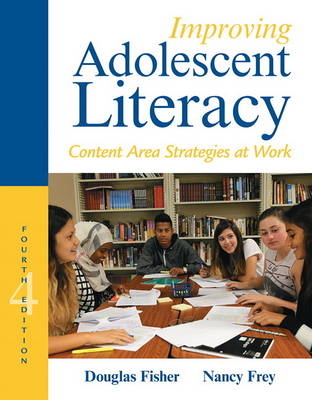
Improving Adolescent Literacy
Pearson (Verlag)
978-0-13-387880-6 (ISBN)
- Titel erscheint in neuer Auflage
- Artikel merken
Practical, straightforward, and affordable, this guide gives middle and secondary school teachers the tools they need to support their students’ comprehension and success in literacy and in content area learning. The classroom-proven strategies and procedures included are taken from the authors’ and their colleagues’ experience in middle and secondary classrooms. Each chapter opens with a vignette from an actual classroom to show readers effective teaching in action and to give them a look at how the chapter’s instructional approach works within content area teaching. Research-based rationales for each strategy follow the vignettes and provide an in-depth look at how to implement the strategy, along with examples of each strategy across the curriculum. The Enhanced Pearson eText features embedded video and assessments.
Improve mastery and retention with the Enhanced Pearson eText*
The Enhanced Pearson eText provides a rich, interactive learning environment designed to improve student mastery of content. The Enhanced Pearson eText is:
Engaging. The new interactive, multimedia learning features were developed by the authors and other subject-matter experts to deepen and enrich the learning experience.
Convenient. Enjoy instant online access from your computer or download the Pearson eText App to read on or offline on your iPad® and Android® tablet.*
Affordable. The Enhanced Pearson eText may be purchased stand-alone or with a loose-leaf version of the text for 40-65% less than a print bound book.
*The Enhanced eText features are only available in the Pearson eText format. They are not available in third-party eTexts or downloads.
*The Pearson eText App is available on Google Play and in the App Store. It requires Android OS 3.1-4, a 7” or 10” tablet, or iPad iOS 5.0 or later.
Douglas Fisher, Ph.D., is Professor of Educational Leadership at San Diego State University and a teacher leader at Health Sciences High & Middle College having been an early intervention teacher and elementary school educator. He is the recipient of an International Reading Association Celebrate Literacy Award, the Farmer award for excellence in writing from the National Council of Teachers of English, as well as a Christa McAuliffe award for excellence in teacher education. He has published numerous articles on reading and literacy, differentiated instruction, and curriculum design as well as books, such as Better Learning Through Structured Teaching, Rigorous Reading, and Text Complexity: Raising Rigor in Reading. Nancy Frey, Ph.D., is a Professor of Literacy in the Department of Educational Leadership at San Diego State University. She is the recipient of the 2008 Early Career Achievement Award from the National Reading Conference. Nancy has published in The Reading Teacher, Journal of Adolescent and Adult Literacy, English Journal, Voices in the Middle, Middle School Journal, Remedial and Special Education, TESOL Journal, Journal of Learning Disabilities, Early Childhood Education Journal, and Educational Leadership. She has co-authored (with Doug Fisher) books on formative assessment (Checking for Understanding and Formative Assessment Action Plan), instructional design (Better Learning for Structured Teaching), data-driven instruction (Using Data to Focus Instructional Improvement), and brain-based learning (In a Reading State of Mind.) Nancy is a credentialed special educator, reading specialist, and administrator in California, and has taught at the elementary, middle, and high school levels for two decades. She is a teacher-leader at Health Sciences High and Middle College, where she learns from her colleagues and students every day.
Chapter 1 Make Content Area Strategies Work for You 1 Shifting Responsibility from Teacher to Students 3 Transparent Teaching and Transportable Learning 3 Distinguishing Teaching from Learning 4 Classroom Assessment Practices 6 Selecting the Right Assessment 6 Types of Informal Assessments 7 Using the Results of Informal Assessments 11 Types of Formal Assessments 11 Using the Results of Formal Assessments 12 Link the Results of Assessment to Instruction 12 Conclusion 13 Chapter 2 Engaging Questions and Discussions 15 Creating Quality Questions 17 Discussions: Structures for Students to Discuss Questions 23 Using Questions and Discussion for Assessment 27 Reciprocal Teaching in English 32 Questioning the Author in English 33 ReQuest in Social Studies 34 Question–Answer Relationships in Science 35 Reciprocal Teaching in Mathematics 37 Student-Generated Questioning in Electives 39 Conclusion 40 Chapter 3 Deepening Interactions with Texts 41 Reading Aloud 42 Planning for Read Alouds in Secondary Classrooms 44 Shared Reading 44 Planning for Shared Reading in Secondary Classrooms 45 Close Reading 49 Planning for Close Reading in Secondary Classrooms 50 Assessment of Interactions with Texts 50 Close Reading in English 51 Shared Reading in Mathematics 52 Shared Reading and Think Alouds in Social Studies 54 Shared Reading in Science 56 Read Alouds and Shared Reading in Electives 56 Conclusion 58 Chapter 4 Robust Vocabulary Learning 61 The Importance of Vocabulary Knowledge 62 Vocabulary Acquisition 63 Vocabulary Instruction 64 Using Vocabulary for Assessment 65 Vocabulary Instruction in English 65 Vocabulary Instruction in Social Studies 68 Vocabulary Instruction in Mathematics 70 Vocabulary Instruction in Science 72 Vocabulary Instruction in Electives 73 Conclusion 75 Chapter 5 Transformative Graphic Organizers 77 Teaching and Learning with Graphic Organizers 78 When to Use a Graphic Organizer 79 Types of Graphic Organizers 81 Teaching Graphic Organizers 84 Using Graphic Organizers for Assessment 84 Graphic Organizers in English 86 Graphic Organizers in Social Studies 89 Graphic Organizers in Mathematics 92 Graphic Organizers in Science 93 Graphic Organizers in Electives 94 Conclusion 96 Chapter 6 Making and Taking Worthy Notes 97 Why Teach Students How to Take Notes? 98 Setting Up Students for Successful Notetaking 99 Using Notetaking and Note Making for Assessment 100 Notetaking in English 102 Notetaking in Mathematics 105 Note Making in Social Studies 107 Taking Notes with Guest Speakers in Social Studies 109 Note Making in Science 111 Notetaking in Electives 113 Conclusion 117 Chapter 7 Purposeful Writing to Learn 119 Defining and Defending Writing to Learn 120 Applying Three Kinds of Knowledge 121 Developing Writing Skills 122 Using Writing Prompts for Assessment 124 Writing to Learn in English 126 Writing to Learn in Mathematics 128 Writing to Learn in Social Studies 130 Writing to Learn in Science 133 Writing to Learn in Electives 135 Conclusion 136 References 137 Index 143
| Erscheint lt. Verlag | 28.1.2015 |
|---|---|
| Sprache | englisch |
| Maße | 100 x 100 mm |
| Gewicht | 100 g |
| Themenwelt | Schulbuch / Wörterbuch |
| Geisteswissenschaften ► Sprach- / Literaturwissenschaft ► Sprachwissenschaft | |
| Sozialwissenschaften ► Pädagogik ► Berufspädagogik | |
| Sozialwissenschaften ► Pädagogik ► Schulpädagogik / Grundschule | |
| ISBN-10 | 0-13-387880-5 / 0133878805 |
| ISBN-13 | 978-0-13-387880-6 / 9780133878806 |
| Zustand | Neuware |
| Informationen gemäß Produktsicherheitsverordnung (GPSR) | |
| Haben Sie eine Frage zum Produkt? |
aus dem Bereich



